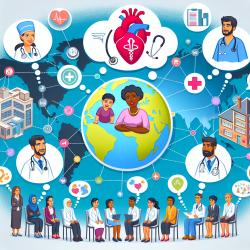Introduction
In the realm of speech-language pathology, practitioners are often challenged with creating effective interventions that are not only evidence-based but also adaptable to diverse populations. Drawing insights from global health strategies, particularly those employed in the Saving Mothers, Giving Life (SMGL) initiative, can offer valuable lessons for enhancing our practice. The SMGL initiative, which focused on increasing demand for facility delivery services in Uganda and Zambia, provides a compelling model for community engagement and empowerment that can be adapted to improve speech-language outcomes in children.
Key Insights from the SMGL Initiative
The SMGL initiative employed a multifaceted approach to reduce maternal deaths by addressing the "first delay" in seeking healthcare. This involved:
- Promoting safe motherhood messages through mass media and community engagement.
- Encouraging birth preparedness and increasing demand for facility delivery through community outreach.
- Providing clean delivery kits and transportation vouchers to reduce financial barriers.
These strategies led to significant increases in facility deliveries and reductions in maternal mortality rates, demonstrating the power of community-based interventions.
Applying SMGL Strategies to Speech-Language Pathology
Speech-language pathologists can draw parallels from the SMGL initiative to enhance their practice. Here are some strategies to consider:
1. Community Engagement and Education
Just as the SMGL initiative used radio and drama to disseminate health messages, speech-language pathologists can leverage local media and community events to raise awareness about speech and language development. Engaging parents, educators, and community leaders in understanding the importance of early intervention can increase the demand for speech-language services.
2. Birth Preparedness and Early Intervention
Encouraging early intervention in speech-language pathology is akin to promoting birth preparedness in maternal health. By educating families about developmental milestones and the signs of speech and language delays, practitioners can empower parents to seek timely assessments and interventions, much like how SMGL encouraged facility deliveries.
3. Reducing Barriers to Access
Financial and logistical barriers can hinder access to speech-language services. Drawing inspiration from SMGL's transportation vouchers, practitioners can advocate for policies that provide financial assistance or transportation support to families in need. Collaborating with schools and community organizations to offer services in accessible locations can also help overcome these barriers.
Encouraging Further Research
The success of the SMGL initiative underscores the importance of data-driven decision-making and continuous evaluation. Speech-language pathologists are encouraged to engage in research that explores the effectiveness of community-based interventions and the impact of reducing barriers to service access. By contributing to the evidence base, practitioners can refine their approaches and improve outcomes for children.
Conclusion
By adapting strategies from global health initiatives like SMGL, speech-language pathologists can enhance their practice and create better outcomes for children. Community engagement, early intervention, and barrier reduction are key components that can drive positive change in speech-language services. To read the original research paper on the SMGL initiative, please follow this link: Addressing the First Delay in Saving Mothers, Giving Life Districts in Uganda and Zambia: Approaches and Results for Increasing Demand for Facility Delivery Services.










